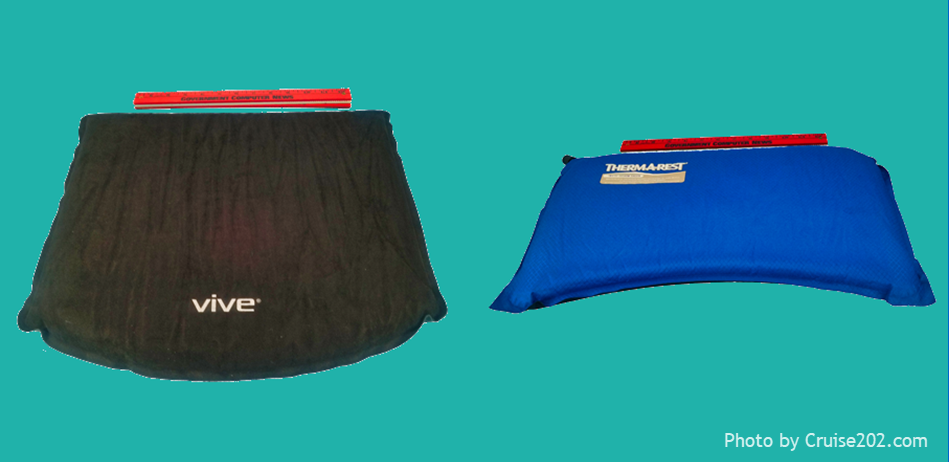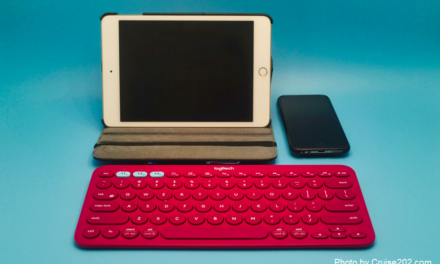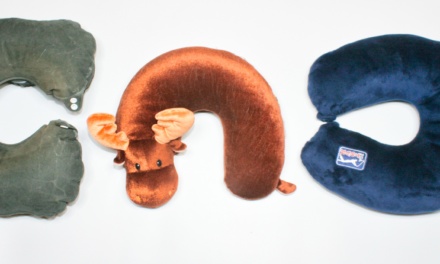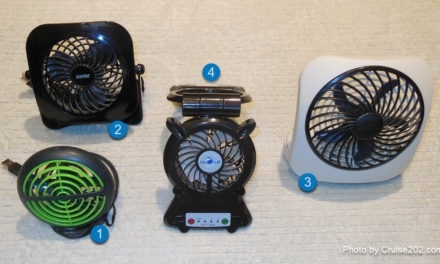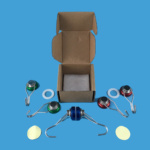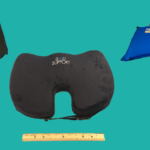Does your butt get sore from the lightly padded seats in modern aircraft? Do you have difficulties getting up from low seats? In this post, I will address these two problems with one solution. Many of the older cruisers with whom I travel have difficulties getting out of seats since many chairs are very low and their knees not so steady. An extra few inches eases the effort for them. Others, like me, find that airline seats are not very comfortable, especially after a few hours. In order to address these two problems, I researched inflatable seat cushions that could easily be carried while traveling.
I found quite a few cushions and spent a lot of time looking at reviews and specs. In the end, I determined that there were a few critical requirements:
Inflation Method
Travel seat cushions come in three styles: foam, blow-up, and self-inflating
Foam Cushions
Foam cushion are not inflatable, but they may be compressible so they fit into a smaller package. They are suitable for persons who want more than 2 inches (51 mm) lift and have the space to carry them. The foam padding (usually memory foam) is very comfortable. The main issue is that they weigh more and generally take up a lot of space, so are less portable. However, they are not susceptible to pressure changes on aircraft. If you require the extra height, consider this option but be aware that foam cushions will be more difficult to lug around.
Blow-Up
Blow-up cushions are inexpensive and very compressible. When flying, you need to be careful to only partially inflate at ground level as the air will expand when your aircraft reaches cruising altitude. Since you must blow these up yourself (or use a pump), they are more difficult to adjust once you sit down. A common complaint was that they explode as a result of putting too much air in and that they punctured easily. I did test one blow up cushion and found that it was also not as comfortable as either a foam pad or the self-inflating pads. If you go with this option, be aware of how you treat your cushion and purchase one which has better puncture resistance.
Self-Inflating
The self-inflating cushion is the option I prefer. These cushions expand when you open the valve and provide the option to add more air by blowing into the valve. I find that letting the pad expand naturally and not adding more air is perfect for flying as the air will expand as the plane climbs – you may actually want to release some air once you reach cruising altitude. These cushions compress easily at the end of the flight – simply open the valve, roll to squeeze out the air, and close the valve so it stays compressed. However, it also became evident that there is a lot of quality variation among the various self-inflating options. I decided to pay a little more for higher quality and was not disappointed.
Size
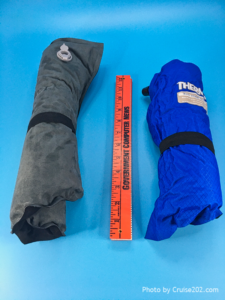 Since one of my primary objectives is to make air travel more pleasant, I am concerned about the size of the pad. I want one that will fit into an economy seat but not one that is too small. Most economy seats are 17-18 inches wide (43-46 cm). Anything wider than this will bunch up in the seat. As it turned out, this was not too much of a limitation, since most products seemed to meet this requirement. And, don’t forget to check the size when deflated. After all, you will need to carry this item around with you.
Since one of my primary objectives is to make air travel more pleasant, I am concerned about the size of the pad. I want one that will fit into an economy seat but not one that is too small. Most economy seats are 17-18 inches wide (43-46 cm). Anything wider than this will bunch up in the seat. As it turned out, this was not too much of a limitation, since most products seemed to meet this requirement. And, don’t forget to check the size when deflated. After all, you will need to carry this item around with you.
Comfort
Comfort is a personal factor. I will review two different configurations below. I found both to be very comfortable, but my wife did not like one of them. Unfortunately, this is not an easy factor to evaluate online and the reviews are not real good indicators. I did manage to find some YouTube reviews on some of the pads under consideration and these were more helpful. While this is not an expensive item, I suggest you might want to take a look at some of these videos. If nothing else, it is humorous to watch what concerns others.
Recommendations
In the end, I settled on two products, each with different specifications. We initially evaluated the products at home to see what felt good, then we tested them on flights to and from Europe (8-10 hours of sitting). The Therm-a-Rest Travel Cushion was highly rated and reviews stated that it was easy on the tailbone. Since it inflates to a little over 2 inches, I purchase this one first. My wife did not like how it felt when she used it, so I them purchased the Vive Inflatable Cushion, which passed the home test with her.
General Features
Now that we have used these cushions, I do have some general recommendations on features to evaluate as you determine what cushion you want.
Slipperiness
It is essential to find a cushion that does not slip easily on the seat. This means it should be covered in some material that not only prevents slipping but is durable. The product specification may provide this information, but also read reviews to see what users say, as this is one of the major complaints for some cushions.
Fill Valve Style
![]()

 There are many different valve styles. Each of the cushions I purchased has a different valve style. I tend to like the twist valve on the Therm-a-Rest cushion over the multi-part valve on the Vive cushion, but both are seem to work fine. The reason I like the twist valve is that I found the cushion expanded too much as the plane climbed and I wanted to let some air out. With the twist valve, I could release some air while I was seated on the cushion and close it when I reached the comfort level I desired. This process was much more difficult with the two-part valve on the Vive.
There are many different valve styles. Each of the cushions I purchased has a different valve style. I tend to like the twist valve on the Therm-a-Rest cushion over the multi-part valve on the Vive cushion, but both are seem to work fine. The reason I like the twist valve is that I found the cushion expanded too much as the plane climbed and I wanted to let some air out. With the twist valve, I could release some air while I was seated on the cushion and close it when I reached the comfort level I desired. This process was much more difficult with the two-part valve on the Vive.
Valve Location
The fill valve should be located on the front corner of the cushion so you can reach it while seated on the pad. This way, you can overfill the cushion, then sit on it and adjust it to your comfort, which is not possible if the valve is not easily reachable.
Shape
I was surprised to find out how many shapes are available. In the end, I determined that there are two basic shapes: full seat and partial seat. The Therm-a-Rest cushion I describe below is a partial seat configuration while the Vive is a full seat.
A full seat cushion is one that fills the entire seat, basically 14 inches (38 cm) or more deep and 15-17 inches wide (38-43 cm) wide so it fits into an airplane economy seat.
The partial seat configurations are marketed as protecting your tailbone by taking the pressure off the spine. This may be something important to you, but the downside is that you are not as well balanced on some of these cushions.
I was comfortable with both cushion sizes, but my wife did not like the partial seat configuration.
Thickness
If you need the height to help you get out of a chair, then pay attention to the thickness of the cushion. I tried to find cushions that were at least 2 inches thick, which seems to be the limit for self-inflating cushions. I found many that were thinner and rejected them. However, this is something that may not be so important for you. Thinner cushions will compress better for packing. Both of the cushions I purchased expand to 2 inches or more.
Therm-a-Rest Travel Cushion
The Therm-a-Rest travel cushion was the first cushion I purchased. I selected this product base on both Amazon and YouTube reviews. This cushion is 16.5 inches wide, 10.5 inches deep, and 2 inches thick (42 cm x 27 cm x 5 cm) so it fits nicely into an airplane seat. It has a twist valve that is easy to use and positioned on the front corner. Since it is not the full depth of the seat, there is no pressure on the tailbone. On the other hand, you may feel like you are balancing on the cushion, which is what my wife felt. I found this cushion to be wonderful, but she did not like it at all.
Pros
- Easy to use valve
- Non-slip surface
- Comfortable after many hours on plane
- Compresses well into small shape
Cons
- Can be difficult to balance on this cushion
- Has Velcro tabs to connect two cushions together – had to cut these off as they snag cloth seats and clothing
Vive Inflatable Cushion
The Vive inflatable cushion is a full seat cushion that is 15” wide, 14” deep, and 2” thick (38 cm x 36 cm x 5 cm). The cushion is very comfortable and does not seem to place pressure on the tailbone. The valve configuration is unusual and may be challenging. The valve is also positioned on the bottom so it is not easily accessible when seated on it. It rolls up easily. Although the compressed rolled-up cushion is larger than the Therm-a-Rest, it is still sufficiently small to fit easily into your personal bag. For long flights, it may be more comfortable since it covers more of the seat.
Pros
- Nice size – fits airline seat well
- Comfortable on long flights
- Non-slip
Cons
- Valve operation and position – not easy to adjust
- Did not seem to be 2” thick (as compared to Therm-a-Rest)
Conclusion
There are many alternatives for inflatable seat cushion. I highly recommend a self-inflating cushion, simply for the ease of use. Both Therm-a-Rest and Vive passed the comfort and quality test. Both offer other configurations as well. Be careful when reading reviews to get current information. Many of these cushions have changed over time, so old reviews can be misleading. For example, the valve shown on Amazon for the Vive cushion is not the one that was received – apparently Vive listened to customers and changed the valve based on negative feedback.
I definitely plan to use a seat cushion for all future long flights. While I don’t need it for everyday activities, I will carry one for my wife who sometimes needs that extra height to get out of low seats.
CAUTION: It is easy to forget that you are using a seat cushion as you rush to get off the plane (I did this in Munich and had to ask the airline to check for the cushion, which they found). Make sure you pack the cushion when you get off.
Please let us know whether you have any opinion on seat cushions in the comments below. Do you use them, either on flights or in other locations? Do you have any preferences?

